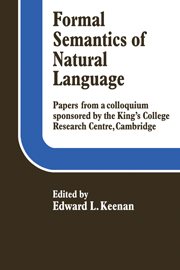Book contents
- Frontmatter
- Contents
- Notes on the contributors
- Acknowledgements
- Introduction
- I QUANTIFICATION IN NATURAL LANGUAGE
- II REFERENCE AND CROSS REFERENCE
- III INTENSIONAL LOGIC AND SYNTACTIC THEORY
- IV QUESTIONING MODEL THEORETIC SEMANTICS
- V PRAGMATICS AND SENTENCES IN CONTEXT
- Pragmatics in natural logic
- Changing the context
- Conditions of the use of sentences and a semantic representation of topic and focus
- Topics, sentence accent, ellipsis: a proposal for their formal treatment
- Preference semantics
- VI SEMANTICS AND SURFACE SYNTAX
Preference semantics
Published online by Cambridge University Press: 05 November 2011
- Frontmatter
- Contents
- Notes on the contributors
- Acknowledgements
- Introduction
- I QUANTIFICATION IN NATURAL LANGUAGE
- II REFERENCE AND CROSS REFERENCE
- III INTENSIONAL LOGIC AND SYNTACTIC THEORY
- IV QUESTIONING MODEL THEORETIC SEMANTICS
- V PRAGMATICS AND SENTENCES IN CONTEXT
- Pragmatics in natural logic
- Changing the context
- Conditions of the use of sentences and a semantic representation of topic and focus
- Topics, sentence accent, ellipsis: a proposal for their formal treatment
- Preference semantics
- VI SEMANTICS AND SURFACE SYNTAX
Summary
Abstract
Preference semantics (PS) is a set of formal procedures for representing the meaning structure of natural language, with a view to embodying that structure within a system that can be said to understand, rather than within what I would call the ‘derivational paradigm’, of transformational grammar (TG) and generative semantics (GS), which seeks to determine the wellformedness, or otherwise, of sentences. I argue that the distinction is not a trivial one, at least not if one genuinely wants to develop a model of human competence. For rejecting utterances is just what humans do not do. They try to understand them.
I outline a system of preference semantics that does this: in operation it has access to the senses of words coded as lexical decomposition trees, formed from a finite inventory of semantic primitives. For each phrase or clause of a complex sentence, the system builds up a network of such trees with the aid of structured items called templates and, at the next level, it structures those networks with higher level items called paraplates. At each stage the system directs itself towards the correct network by always opting for the most ‘semantically dense’ one it can construct. I suggest that this opting for the ‘greatest semantic density’ can be seen as an interpretation of Joos' (1972) ‘Semantic axiom number one’.
I argue that the analysis of quite simple examples requires the use of inductive rules of inference which cannot, theoretically cannot, be accommodated within the derivational paradigm.
- Type
- Chapter
- Information
- Formal Semantics of Natural Language , pp. 329 - 348Publisher: Cambridge University PressPrint publication year: 1975
- 29
- Cited by



